Deaths 85 (+ 1 bomber) Start date July 18, 1994 | Non-fatal injuries 300+ Attack type Car bomb | |
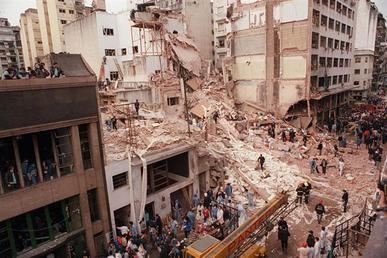 | ||
Similar 1992 attack on Israeli embassy, República Cromañón nightclub, 2012 Buenos Aires rail, 1998 United States em | ||
The AMIA bombing was an attack on the Asociación Mutual Israelita Argentina (AMIA; Argentine Israelite Mutual Association) building. It occurred in Buenos Aires on 18 July 1994, killing 85 people and injuring hundreds. It was Argentina's deadliest bombing ever. Argentina is home to a Jewish community of 230,000, the largest in Latin America and sixth in the world outside Israel (see Demographics of Argentina).
Contents
- Amia bombing 19 years later by memoria activa
- Bombing
- Other bombings
- Investigation and responsibility
- Ibrahim Hussein Berro
- Juan Jos Galeanos investigations
- Investigations under Nstor Kirchners government
- Developments under Cristina Fernndez de Kirchners government
- Official Argentine government findings
- Alleged assassinations of perpetrators
- Memorandum of understanding
- Recent developments
- Other opinions
- Cultural depictions
- References
Over the years, the case has been marked by incompetence and accusations of cover-ups. All suspects in the "local connection" (among them, many members of the Buenos Aires Provincial Police) were found to be "not guilty" in September 2004. In August 2005, federal judge Juan José Galeano, in charge of the case, was impeached and removed from his post on a charge of "serious" irregularities due to mishandling of the investigation. In 2005, Cardinal Jorge Mario Bergoglio, who would later become Pope Francis, was the first public personality to sign a petition for justice in the AMIA bombing case. He was one of the signatories on a document called “85 victims, 85 signatures” as part of the bombing’s 11th anniversary.
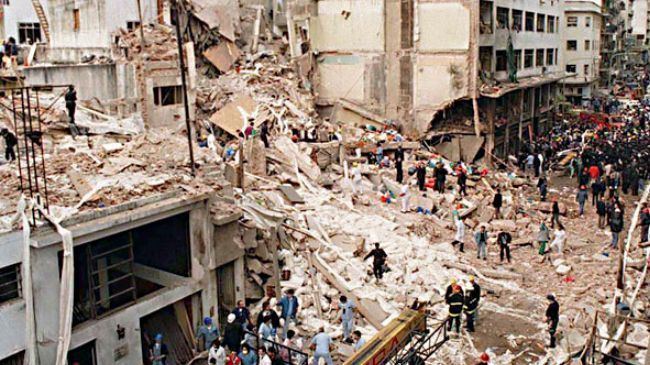
On 25 October 2006, Argentine prosecutors Alberto Nisman and Marcelo Martínez Burgos formally accused the government of Iran of directing the bombing, and the Hezbollah militia of carrying it out. According to the prosecution's claims in 2006, Argentina had been targeted by Iran after Buenos Aires' decision to suspend a nuclear technology transfer contract to Tehran. This has been disputed because the contract was never terminated, and Iran and Argentina were negotiating on restoration of full cooperation on all agreements from early 1992 until 1994, when the bombing occurred.
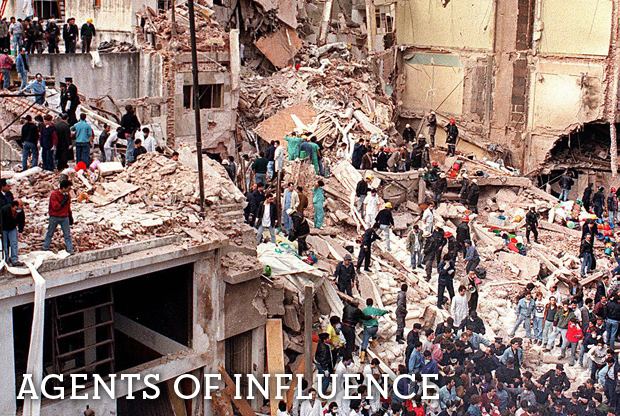
The thirteenth anniversary of the bombing was commemorated on 18 July 2007. In addition to nationwide exhibitions and ceremonies, radio and television stations and police cars all across Argentina sounded sirens at 9:53 am, the time of the bombing.
Amia bombing 19 years later by memoria activa
Bombing
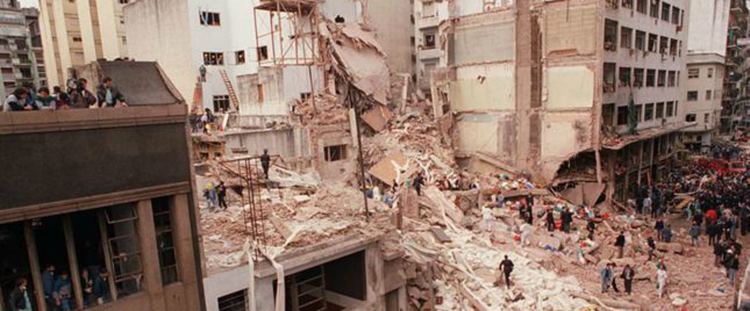
On 18 July 1994, a suicide bomber drove a Renault Trafic van bomb loaded with about 275 kilograms (606 lb) of ammonium nitrate fertilizer and fuel oil explosive mixture, into the Jewish Community Center building located in a densely constructed commercial area of Buenos Aires. The explosive is thought to have been arranged to focus the blast on the building 3 to 5 metres (9.8 to 16.4 ft) away, exhibiting a shaped charge or explosively formed penetrator effect. The exterior walls of this five story building were of brick masonry construction, which supported the floor slabs. The air blast from the bomb totally destroyed the exposed load-bearing walls which, in turn, led to progressive failure of the floor slabs and virtually total collapse of the building. Such bearing-wall buildings are notable for their tendency to be brought down in this manner by localized damage.
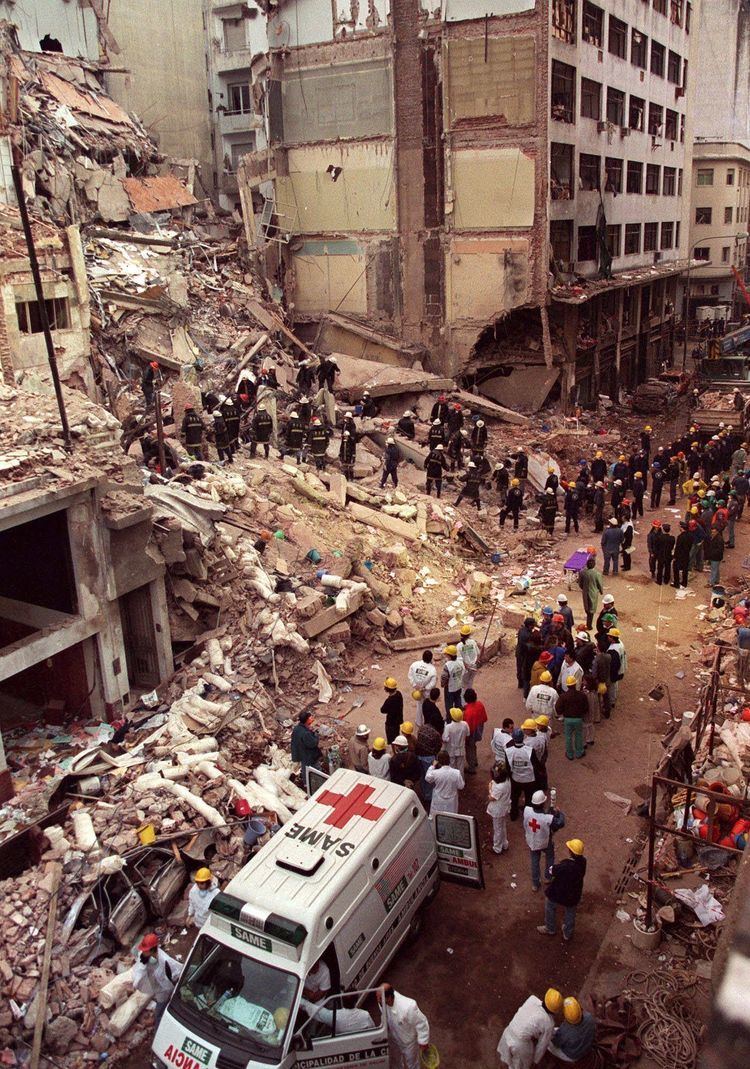
In the days following the bombing, Israel sent Mossad agents to Argentina to investigate. The Israeli Police also sent a team of four forensic scientists to assist with the building of ante mortem files and victim identification; the IDF sent personnel to help the Argentines with body extrication. Argentina closed its borders after the attack, fearing more terrorists could enter. It was thought possible that the bombers entered Argentina through the Triple Frontier, where the borders of Argentina, Brazil, and Paraguay meet. Argentina's intelligence agency, the Secretaría de Inteligencia (SIDE), is said to have set up a network of surveillance called "Centauro" in Paraguay.
Other bombings
The bombing came two years after the 17 March 1992 bombing of the Israeli Embassy in Buenos Aires which killed 29 and wounded 242, and was Argentina's deadliest attack until the AMIA bombing. The Islamic Jihad Organization, which according to Robert Baer operates under the umbrella of Hezbollah and is linked to Iran, claimed responsibility for that bombing. Some suspect that the AMIA bombing was connected to the embassy attack. To date, authorities have been unable to locate those responsible for either of the two bombings.
The day after the AMIA attack, a suicide bombing on a Panamanian commuter plane killed all 21 passengers, 12 of whom were Jews. Investigators determined that the bombing was perpetrated by a "Lya Jamal" – thought to be "an Arab traveling under an alias, using fraudulently obtained Colombian documents."
Eight days after the AMIA attack, the Israeli embassy in London was car-bombed, and thirteen hours later a similar car bomb exploded outside a Jewish community centre in London. No one was killed but 22 were injured and "millions of pounds of damage" was done. Five Palestinians were later arrested in London and two convicted and sentenced to 20 years in prison in connection with the bombings.
Investigation and responsibility
No suspects have been convicted for the bombing and there have been many allegations made, including those blaming the government of Iran. The investigations were marred by incompetence; former President Néstor Kirchner called them a "national disgrace" in 2005. In 1999 an arrest warrant was issued against Hezbollah member Imad Mugniyah in connection with the attack. Argentine justice accused Tehran in 2006 of being behind the attacks, allegedly because of Buenos Aires' decision to suspend a nuclear material delivery and technology transfer.
Ibrahim Hussein Berro
Israeli diplomatic sources who read the "final" report by SIDE on the attack said in 2003 that the attack was a suicide bombing carried out by Ibrahim Hussein Berro, a 21-year-old Hezbollah operative who has been honored with a plaque in southern Lebanon for his "martyrdom" on 18 July 1994, the date of the bombing. This investigation was carried out jointly with the U.S. Federal Bureau of Investigation. Hussein had been identified by FBI and Argentine intelligence, and corroborated by at least three witnesses. According to official Argentine government prosecutor, Alberto Nisman, Hussein's two US-based brothers had testified that he had joined the radical Shia militant group Hezbollah. "The brothers' testimony was substantial, rich in detail and showed that he was the one who was killed," Nisman added.
However, a BBC correspondent reported that "independent" investigators were skeptical, and they pointed out repeated incompetence and deception in the official investigation. No proper autopsies or DNA tests were done. The police had also simply dumped a head, thought to be that of the bomber, into a bin.
Juan José Galeano's investigations
Federal judge Juan José Galeano followed investigations concerning the "local connection", which included members of the Policía Bonaerense (Buenos Aires Provincial Police). He quickly arrested Carlos Telleldín, alleged to have provided the van used in the bombing, and some 20 officers from the Bonaerense. But a video broadcast on Argentine TV showed him offering Telleldín $400,000, in return for evidence, which led to Galeano's removal from the case in 2003, and his impeachment in August 2005.
Judge Galeano had also issued warrants for the arrests of 12 Iranians, including Hade Soleimanpour, Iran's ambassador to Argentina in 1994. The latter was arrested in the UK on 21 August 2003, at the request of the Argentine authorities. He was later released because, according to the Home Office, there was not even enough evidence presented to make a prima facie case for the extradition to proceed.
Judge Galeano also interviewed Abolghasem Mesbahi, aka "Witness C", an alleged former Iranian intelligence officer who reportedly said a former Argentine president accepted a $10 million payment from Tehran to block the investigation. Former President Carlos Menem denied the claims, but admitted he had a secret Swiss bank account following a report in the New York Times. Menem claimed in 2004 that the attack had been related to his support to the US during the First Gulf War and to his visit to Israel during his mandate. Abolghasem Mesbahi claimed to the Argentine court that Iran had planned the bombing, thinking the centre was a base for the Israeli secret service.
On 2 September 2004, all suspects in the "local connection" (among whom members of the Buenos Aires police) of AMIA case were found to be not guilty. Five persons, including four policemen, were therefore acquitted because of lack of evidence.
On 3 August 2005, Judge Galeano's impeachment was successful, and he was formally removed from his post as a federal judge for "serious" irregularities and his mishandling of the investigation. Argentine newspaper Clarín reports that charges will be pressed against him shortly. Judge Galeano has denied these allegations.
In March 2005, Swiss judge Jacques Antenen, in charge of investigations concerning the murder of an Iranian dissident, re-opened the case concerning Iranian intelligence service bank accounts in Switzerland. The same account would have been used both for this assassination and for the alleged payment of ex-President Carlos Menem. Swiss Justice had already been notified of the existence of an account owned by the Red Spark Foundation (based in Liechtenstein), in which Ramón Hernández, former secretary of Carlos Menem, had authority to sign documents. Six million dollars would have been deposited in this account, although in some moment the exact amount was said to be of $10 million.
In 2006, the Court of Cassation declared that the previous court had made a false version of the investigated acts in order to cover irresponsibilities.
Investigations under Néstor Kirchner's government
Néstor Kirchner's government issued a decree in July 2005 formally accepting a share of the blame for the failure of investigations about the attack. He called the unresolved investigations a "national disgrace.". President Kirchner said governments had covered up facts, and that the decree established a mechanism for victims to receive compensation. Shortly after assuming his functions in spring 2003, he opened up Argentine intelligence files on the case, and lifted a decree preventing SIDE agents from testifying in the case.
Argentina's justice, Israel, and the United States suspected in 2005 that Hezbollah was behind the attack, with backing from Iran. Hezbollah has denied responsibility. The Iranian government maintains its innocence, condemning the terrorist attack and calling for urgent punishment of those responsible.
On 25 October 2006, prosecutors in Buenos Aires formally charged Iran and Shi'a militia Hezbollah with the bombing, accusing the Iranian authorities of directing Hezbollah to carry out the attack and calling for the arrest of former President of Iran Ayatollah Hashemi Rafsanjani and seven others, including some who still hold official positions in Iran.
Speaking on state radio, Iranian foreign ministry spokesman Mohammad Ali Hoseyni described the accusations against the country as "a Zionist plot". Both Hezbollah and Iran deny any involvement in the bombing. According to Hoseyni, the accusations were intended to divert "world attention from the perpetration of crimes by the Zionists against women and children in Palestine".
On 6 March 2007, former Congressman Mario Cafiero and former government official Luis D'Elia provided evidence at a press conference that Abolghasem Mesbahi, along with two other Iranians that gave alleged evidence implicating Iran in the bombing, were members of the People's Mujahedin of Iran (MEK), which is an organization that advocates the overthrow of the Islamic Republic of Iran and was designated until 2012 as a terrorist organization by the US. They also said that there were arrest warrants issued by Interpol for the other two Iranians, Hadi Roshanravani and Hamid Reza Eshagi.
Developments under Cristina Fernández de Kirchner's government
In 2012, Argentina's President Cristina Fernández de Kirchner announced at the United Nations General Assembly that Iran and Argentina would meet to discuss Iranian involvement in the attacks. In 2014 she also criticized her country's Jewish leaders since that they not supporting Argentina's pact with Iran in order to jointly investigate the 1994 AMIA bombing attack.
Argentina's Foreign Minister Hector Timerman and Iranian Foreign Minister Ali Akbar Salehi met on the sidelines of the UN in New York and promised to continue talks until the 1990s bombings are resolved.
Writing in the Jerusalem Post in December 2012, Cynthia Ferman argues that despite Kirchner's announcement, Argentina will "continue to (mis)lead the victims of terror by providing them with false hope for a just resolution." In addition, she writes that "it seems unlikely that Iran will hand over its high-ranking government officials to Argentina."
Official Argentine government findings
Argentines prosecutors formally charged the Iranian authorities of directing Hezbollah to carry out the attack. The Justice called for the arrest of top Iranian authorities. The Iranian defense minister, Ahmad Vahidi was accused of masterminding the attack.
Argentine's government required the extradition of those accused of the attack but Iran has always refused to accept the verdict of the Argentine's Justice.
In November 2007, Interpol on behalf of the Argentine government, published the names of six individuals officially accused for their role in the terrorist attack. They were entered in the Interpol red notice list.
In November 2008, Carlos Menem was called to testify in an upcoming trial over the AMIA case.
In March 2009, a former investigator in the case, Claudio Lifschitz, claimed he was abducted and tortured by men who told him not to investigate SIDE's involvement in the case.
In August 2009, BBC News reported that Ahmad Vahidi had become Iran's defense minister-designate under the 2009 Mahmoud Ahmadinejad administration, and is on Interpol's wanted list over the AMIA bombing. Vahidi led a unit of Iran's Revolutionary Guard called Quds Force at the time of the attack, and has been accused of planning the bombings. Iran dismissed this development as a "Zionist plot". On 1 June 2011, Bolivia apologized to Argentina for Ahmad Vahidi's unannounced visit to the country, and announced that he would be leaving Bolivia immediately.
On 31 March 2012, Menem was ordered to stand trial for obstruction of justice in the probe of the AMIA bombing. Menem is accused of helping to cover up the tracks of local accomplices of the attackers.
Alleged assassinations of perpetrators
In January 2014, Yitzhak Aviran, who had been Israel's ambassador to Argentina at the time, claimed in an interview with a Spanish-language Jewish newspaper that most of the perpetrators of the attack had been tracked down and killed by Mossad, Israel's secret service, saying "a majority of those responsible for the act are no longer alive, and we took care of this on our own." Aviran's statements caused concern in Argentina, whose Foreign Minister, Héctor Timerman, accused Israel of having thus "prevented the gathering of new evidence that could shed light on the affair." Argentina also summoned the Israeli chargé d'affaires to ask for explanations about Aviran's statements. For its part, the Israeli government, through its own Foreign Ministry, dismissed Aviran's claims as "complete nonsense."
Memorandum of understanding
On 27 January 2013, the Government of Argentina announced it had signed a memorandum of understanding with Iran to establish a "truth commission" to investigate the AMIA Bombing. According to President Kirchner, the commission was established to "analyze all the documentation presented to date by the judicial authorities of Argentina and Iran…and to give its vision and issue a report with recommendations about how the case should proceed within the legal and regulatory framework of both parties."
The news generated several criticisms with David Harris from the American Jewish Committee stating that "the idea of establishing a 'truth' commission on the AMIA tragedy that involves the Iranian regime would be like asking Nazi Germany to help establish the facts of Kristallnacht". The U.S. State Department's top official in charge of Latin American affairs, Assistant Secretary of State Roberta Jacobson, said she is "skeptical that a just solution can be found" through the Argentine-Iran "truth-commission." The Jewish community in Argentina issued the statement "to ignore everything that Argentine justice has done and to replace it with a commission that, in the best of cases, will issue, without any defined deadline, a 'recommendation' to the parties constitutes, without doubt, a reversal in the common objective of obtaining justice."
On 28 February 2013, the Argentine Chamber of Deputies approved the memorandum of understanding with Iran by 131 votes in favor to 113 votes against. Israel expressed disappointment at this development. Guillermo Borger, president of the AMIA, criticized the legality of the memorandum and announced that he would take it to the Supreme Court of Argentina.
In May 2014, Memorandun was declared unconstitutional by the Court. The memorandum was voided when Mauricio Macri became president of Argentina, as he withdrew the appeal that the Kirchners government had filed.
Recent developments
On 24 May 2013, it was reported that two of the Iranian AMIA bombing suspects accused of having planned the attack, Mohsen Rezai and Ali Akbar Velayati, are current candidates for the Iranian presidential elections. In May 2013, Prosecutor Alberto Nisman published a 502-page indictment accusing Iran of establishing terrorist networks throughout Latin America – including in Argentina, Brazil, Paraguay, Uruguay, Chile, Colombia, Guyana, Trinidad and Tobago and Suriname – dating back to the 1980s. Nisman also said new evidence underscored the responsibility of Mohsen Rabbani, the former Iranian cultural attache in Argentina, as mastermind of the AMIA bombing and "coordinator of the Iranian infiltration of South America, especially in Guyana", and said US court documents showed Islamist militant Abdul Kadir – who was sentenced to life in prison in 2010 for participating in a foiled plan to attack John F. Kennedy International Airport in New York – was Rabbani's disciple.
The JTA reports that ex-interior minister of Argentina, Carlos Vladimir Corach, is to be investigated for his ties to the AMIA Jewish center bombing. He is alleged to have provided an illegal payment of $400,000 to Carlos Telleldin.
In an interview with Buenos Aires-based Jewish news agency (Agencia Judía de Noticias) on 2 January 2013, Itzhak Aviran, who was the Israeli ambassador to Argentina from 1993 to 2000, said most of the people behind the AMIA attack were eliminated by Israeli security agents operating abroad. Israeli Foreign Ministry spokesman Yigal Palmor called Aviran's declarations "complete nonsense".
In January 2015, the prosecutor in charge of the AMIA bombing investigation, Alberto Nisman, filed a 300-page complaint accusing President Cristina Fernández de Kirchner and Foreign Minister Héctor Timerman among other pro-government political figures of "covering up" Iranian citizens allegedly involved in the 1994 attack. Nisman said his accusations were based on phone taps on close political allies of Fernández, who he said conspired in a "sophisticated criminal plan" to negotiate with Rabbani himself, one of the main suspects of perpetrating the deadly bombing. According to the accusation, Iranian oil would be exchanged for Argentinian grain, while Argentina would cancel an international Interpol arrest warrant against Rabbani and other senior Iranian officials. Nisman demanded a preventive embargo of 200 million pesos on Ferández de Kirchner and requested to question her, as well as Timerman, lawmaker of the pro-government organization "La Cámpora" Andrés Larroque, political leader Luis D'Elía, the leader of Quebracho Fernando Esteche, members of Secretariat of Intelligence, the leader of the Iranian community in Argentina Jorge "Yussuf" Khali, and ex attorney and judge Héctor Yrimia. On 18 January 2015, Nisman was found dead at his home in Buenos Aires, hours before he was due to explain his allegations at the Argentine parliament. A gun and spent shell casing were found next to the body, and a government official said the death was likely a suicide although others considered the death suspicious. The judge Ariel Lijo returned immediately from his vacations to work in the case, and to order the protection of Nisman's proofs. Nisman was replaced by prosecutor Alberto Gentili.
In the week following Nisman's death, and despite the fact that Nisman was going to implicate her among others had he lived, President Kirschner declared her determination to replace the Argentinian secret security service completely because it had been run beyond the state's control for too long.
In March 2015, three former Venezuelan government officials interviewed by Veja stated that Hugo Chávez and Mahmoud Ahmadinejad allegedly met in 2007 to discuss payments to the Argentine government of Cristina Kirchner in order for Iran to receive Argentine nuclear technology and the cessation of work between Argentina and Interpol involving Iranian individuals.
In March 2015, the Argentinian government released a full-page advertisement in national newspapers accusing the late prosecutor Alberto Nisman of having attempted to destabilise the country. The advertisement also argued that the country should revive a controversial agreement with Iran, the country that is suspected of being responsible for the bombings. In addition to that, during a speech president Cristina Fernández de Kirchner accused Israel of being responsible for the 1992 bombing of the Israeli embassy in Argentina. This accusation was based on the allegation that Israel was only demanding justice for the AMIA bombing but not for the embassy attack. This was immediately refuted by the Israeli embassy, which reaffirmed that it does in fact demand justice for both cases. This allegation was made despite the fact that an Islamist group linked to Iran and possibly Hezbollah claimed responsibility.
On 26 February 2016, the Argentine prosecutor Ricardo Sáenz stated Nisman's death "was a homicide indeed", claiming the cause should be directed to the federal justice.
Other opinions
According to a report in The Nation, the author claims that James Cheek, United States Ambassador to Argentina at the time of the bombing, told him, "To my knowledge, there was never any real evidence [of Iranian responsibility]. They never came up with anything." The hottest lead in the case, he recalled, was an Iranian defector named Manoucher Moatamer, who "supposedly had all this information." But Moatamer turned out to be only a dissatisfied low-ranking official without the knowledge of government decision-making that he had claimed. "We finally decided that he wasn't credible," Cheek recalled.
In 2013, American investigative journalist Gareth Porter cast doubt on the alleged involvement of Iran and Hezbollah, reporting that the link depended centrally on just claims from the People's Mujahedin of Iran, a controversial Iranian anti-regime group that has been described as terrorist by some nations.
The Debkafile, an Israeli military intelligence website, reported on 19 February 2015 that Nisman had been killed by an Iranian posing as a defector who had spent four years to build trust. He had secretly rented an apartment next door. He murdered Nisman with a gun that Nisman had borrowed from a friend, and then escaped through the central heating system connecting the two flats. His Argentinean confederates had earlier disarmed the security cameras in the building and so he was able to walk out, reach the airport and fly out on a false passport to Montevideo, then to Dubai and finally to Tehran. He was long gone when the prosecutor was found lifeless in a pool of blood in his bathroom, killed by a single bullet to the head from a small 22-caliber gun.
Cultural depictions
Ten years after the terrorist attack, a group of 10 Argentine directors, each financed by a different production company, filmed a collection of 10 shorts in tribute to the victims of the attack. The shorts were collected in the film 18-j, dubbed thus in reference to the date of the attack. The directors were Daniel Burman, Israel Adrián Caetano, Lucía Cedrón, Alejandro Doria, Alberto Lecchi, Sergio Renán, Marcelo Schapces, Carlos Sorín, Juan Bautista Stagnaro, Adrián Suar and Mauricio Wainrot; a small introduction was narrated by actress Norma Aleandro. Each short showed a different scene in the lives of those who witnessed the attack first-hand. The film premiered 19 August 2004.
In 2009, Marcos Carnevale directed Anita, a full-length film which portrays a young woman (Alejandra Manzo) with Down Syndrome who is lost in Buenos Aires after her mother is killed in the AMIA bombing.
